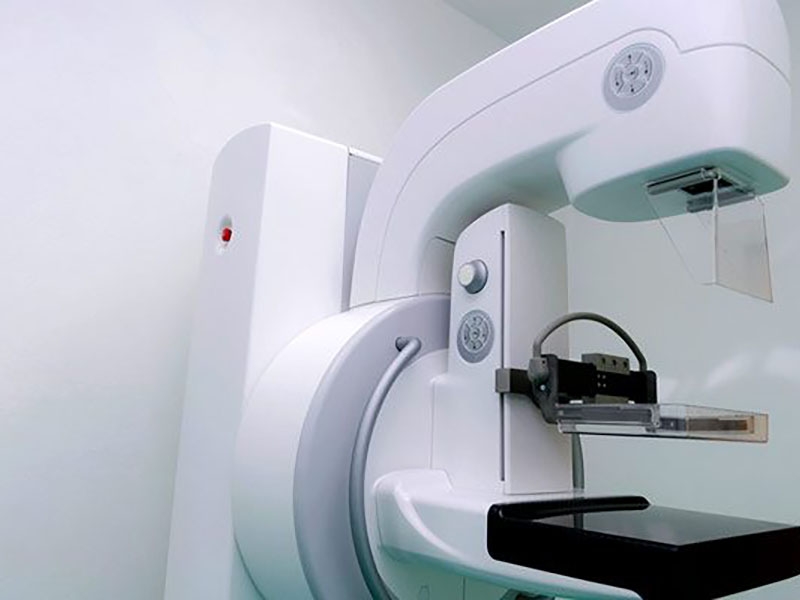
Mammography
Watch our video about Mammography
Mammography is a specialized X-Ray imaging technique used to examine breast tissue for early signs of cancer and other abnormalities. This test is a crucial screening and diagnostic tool for detecting breast tumors, calcifications, and structural changes that may indicate a disease.
Mammograms play a vital role in preventive healthcare, helping detect breast cancer at an early stage, even before symptoms appear. The procedure is quick, safe, and highly effective, making it an essential part of women’s health screenings.
What is Mammography Used For?
Mammography is primarily used for:
- Early detection of breast cancer in women with or without symptoms.
- Investigating lumps, pain, or other breast abnormalities.
- Monitoring changes in breast tissue over time.
- Assessing calcifications or cysts that may require further evaluation.
- Detecting abnormalities in dense breast tissue.
- Guiding biopsies or further diagnostic procedures.
- Evaluating breast health before and after treatment for breast conditions.
By identifying breast abnormalities before they become serious, mammography significantly improves chances of early treatment and recovery.
How Does Mammography Work?
The mammogram procedure follows these key steps:
- Breast Positioning: The patient stands in front of the mammography machine, and the breast is carefully positioned on a flat surface.
- Compression: A plastic plate compresses the breast tissue to spread it evenly and capture clearer images. This step is crucial for detecting small abnormalities that may not be visible otherwise.
- X-Ray Imaging: Low-dose X-rays pass through the breast tissue, creating detailed black-and-white images that highlight any irregularities.
The procedure takes only a few minutes, and while the compression may cause mild discomfort, it is temporary and necessary for accurate imaging.
Types of Mammography
There are different types of mammograms, each designed to provide specific imaging benefits.
1. Screening Mammography
A Screening Mammogram is performed as a routine check-up for women without symptoms, usually recommended every 1-2 years for women over 40.
This type of mammogram is designed to detect abnormalities early, even before a lump is noticeable. The images are compared over time to identify small changes in breast tissue.
2. Diagnostic Mammography
A Diagnostic Mammogram is performed when a breast abnormality is detected in a screening mammogram or through a physical exam.
It involves additional imaging angles and magnifications, allowing radiologists to examine specific areas of concern in greater detail. This is an important step when investigating lumps, pain, nipple discharge, or previous abnormal results.
3. 3D Mammography (Digital Breast Tomosynthesis – DBT)
3D Mammography is an advanced technique that captures multiple images of the breast from different angles to create a three-dimensional image.
This type of mammogram is especially useful for women with dense breast tissue, as it reduces false positives and improves cancer detection rates. The images allow doctors to examine layers of breast tissue individually, providing a clearer and more accurate diagnosis.
What Conditions Can a Mammogram Detect?
Mammography helps diagnose a variety of breast conditions, including:
- Breast Cancer – Detects tumors at an early stage, improving treatment outcomes.
- Fibroadenomas – Benign (non-cancerous) lumps in breast tissue.
- Cysts – Fluid-filled sacs that can appear as lumps in the breast.
- Microcalcifications – Small calcium deposits that may indicate early cancer.
- Ductal Carcinoma in Situ (DCIS) – A pre-cancerous condition that can develop into invasive cancer if untreated.
- Structural Changes in Breast Tissue – Detects changes caused by trauma, infections, or hormonal fluctuations.
- Breast Density Evaluation – Helps identify women who may need additional imaging for accurate results.
When is a Mammogram Recommended?
A mammogram is recommended in various situations, including:
- Routine Screening for Women Over 40 – Annual or biennial exams for early detection.
- Family History of Breast Cancer – Women with a genetic predisposition should start screening earlier.
- Breast Pain or Lumps – To investigate unexplained changes in breast tissue.
- Nipple Discharge or Skin Changes – To rule out infections, cysts, or tumors.
- Dense Breast Tissue – Women with dense breasts may need advanced imaging like 3D mammography.
- Post-Treatment Monitoring – To check for recurrence after breast cancer treatment.
- Changes Detected in Previous Mammograms – Follow-up imaging for suspicious or unclear findings.
Pre and Post-Mammogram Care
Before the Mammogram:
- Avoid using deodorants, lotions, or powders on the day of the exam, as they may interfere with imaging.
- Schedule the exam at a time when your breasts are less sensitive, usually a week after your period.
- Wear a two-piece outfit for easy access during the procedure.
After the Mammogram:
- Normal activities can be resumed immediately after the procedure.
- If additional imaging is required, follow your doctor’s recommendations.
- Discuss results with your healthcare provider, who will explain findings and next steps if necessary.
Contraindications for Mammography
While mammography is a safe and essential screening tool, it may not be recommended for:
- Pregnant women, unless absolutely necessary.
- Women under 30, unless they have a high risk of breast cancer.
- Patients with recent breast surgeries or implants, requiring special imaging techniques.
- Individuals with extreme breast sensitivity, who may need alternative imaging methods.
For these cases, alternative diagnostic tests may be recommended.
Alternatives for Patients Who Cannot Undergo a Mammogram
For individuals unable to undergo a mammogram, other imaging options include:
- Breast Ultrasound – A radiation-free method to examine lumps and dense breast tissue.
- MRI (Magnetic Resonance Imaging) – Used for high-risk patients and detailed breast cancer screening.
- Breast Biopsy – A direct tissue sample analysis for more accurate diagnosis.
Schedule Your Mammogram at Clinic Consultation
Mammography services are available at Clinic Consultation, performed with state-of-the-art imaging technology for early breast cancer detection and breast health monitoring.
📅 Book your mammogram appointment today and prioritize your breast health with expert care and accurate diagnostics!
Click here to schedule an appointment online